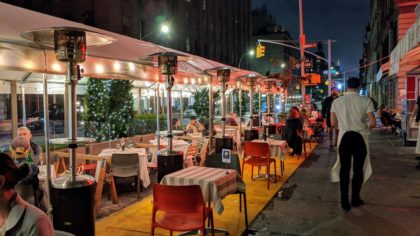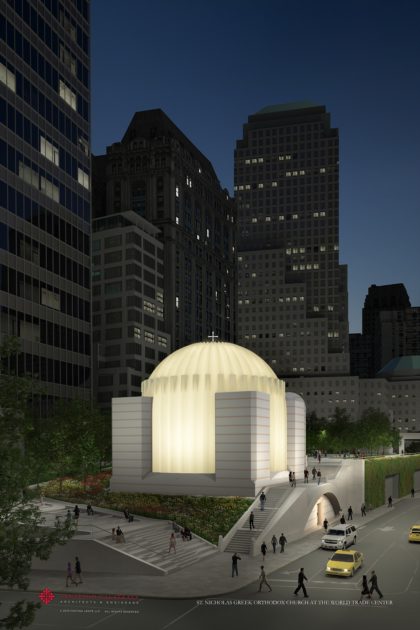Categories
Left column house ads
In the News: City Planning moves to make curbside structures permanent
November 16, 2021 Arts & Culture, Real Estate, Restaurant/Bar News
CURBSIDE DINING TO STAY
Crain’s reports that the City Planning Commission approved a text amendment to the city’s zoning code taht would allow the outdoor seating areas permanent in 2022. “Ten out of 11 members of the commission voted yes after a series of contentious meetings where residents of restaurant-heavy neighborhoods complained about multiplying rat populations, all-night noise and the fishbowl feeling of going about the intimate routine of daily life inches from a rotating cast of restaurant diners. Yet the City Planning Commission indicated that the chance to reconsider how the city uses its streets was too good to pass up.”
ST. NICK ON ITS WAY
YIMBY has some good shots of the St. Nicholas Greek Orthodox Church at the WTC. I’ll get down there myself soonish…
SHOUT OUT TO TRIBECA ROGUE
Architzer, the blog for architects, gives a shout out to Tribeca Rogue, the bronze building by Woods Bagot at Church and Chambers, calling it a “study in how to reinterpret context, materials and tradition.”
HOWARD HUGHES SCALES BACK MUSEUM DONATION
The Howard Hughes Corp. will pay $40 million for the air rights at Pier 17 in order to build 250 Water and the city will set that aside for the Seaport Museum, according to The Real Deal. As you might recall, this is $10 million less than originally promised, but HHC claims there are also less air rights being transferred since the building was reduced in size — 234,630 square feet now instead of 415,000. It never occurred to me that the city was just moving the sale of air rights to the museum, but maybe I missed that…
13 Comments
Comment:
Subscribe
Subscribe to the TC Newsletter













Great news about outdoor dining. Rats/cleanliness and noise are genuine concerns, but they can and should be dealt with by regulating design/use, fining owners/landlords, etc.
Outdoor dining is widely beloved and an infinitely better use of street space than private parking.
And we are still in a pandemic so a good on that front too.
What does this mean: “the fishbowl feeling of going about the intimate routine of daily life inches from a rotating cast of restaurant diners”? Outdoor dining is in public, and part of public and social life is people-watching and interaction. One might as well call all of NYC (or any city or town) a “fishbowl”. Of course, for an introvert, the constant scene of “seeing and being seen” can be exhausting, but that’s always been part of city living, and isn’t it part of the appeal for many? I’m not sure I understand this concern (and I am an introvert).
This seems like a great idea. It’s far better use of the space than parking. However, the plan might include some general guidelines as to aesthetics, upkeep and cleanliness, and safety of the structures (including perhaps safety barriers against the mad vehicle traffic, at least on busy streets and intersections). And of course, proprietors should be considerate of others living in the neighborhood or just using the sidewalks. Sidewalk clearances and throughways have to be kept open; noise levels should be kept reasonable for the sake of neighbors.
I’m glad to have these on our street in Tribeca. They add a positive sense of street life to our block; the sheds are built aesthetically; the patrons have been well-behaved. I think it makes the street feel safer at night also; previously the street could feel quite desolate at night.
Of course they may not be appropriate for some traditionally very quiet streets, so decisions may have to be approved on a case-by-case process. How would that work? Should neighbors on a street have a say in approvals?
Design requirements like you mention already exist and are certainly part of the permanent plan, but I am curious about how the final guidelines will look. The more I think about it, the less I think shacks/sheds are a good long-term idea. Permanent outdoor dining should just be moveable tables/chairs/umbrellas surrounded by planters in the street. No cheap plywood boxes lining the street and no bulky structures obstructing lines of sight.
Though some are tastefully done (Locanda), the shacks can be pretty unsightly (Wolfgang’s) compared to the beautiful architecture around our city and, most importantly, they’re impossible to clean underneath. That’s where standing water and food scraps get easily trapped, which attracts rats, flies, and stench (L’angolo and Zona). The shacks also pose a challenge for streetsweepers and plows.
Allowing only for simple setups of moveable planters, tables, chairs, and umbrellas instead of shacks will solve a lot of the negative externalities.
Permanent outdoor dining should be about creating a weather-permitting nicety, not about creating makeshift indoor areas outside. That was needed during covid winters, but not post-covid when people can and will simply eat indoors. Open air is nicer anyway.
Yes, I see your point… I also wonder how street repairs and repaving will be dealt with.
Another approach is to widen sidewalks instead, at least where appropriate, and allow more sidewalk seating, perhaps under a retractable awning attached to the building, so no need for a shed.
(P.S. My last two messages required at least 7 different Catchpas!)
Sorry about that — the bots are quite ferocious these days, so I think my spam catcher is trying to battle those…
I wish I’d taken a picture of what Reade Street looked like the day they dismantled the shed for Reade Street Pub. What can only be described as part muck, part plastic refuse and part sand from winter storm preparation was piled at least 3″ deep in the shape of the footprint of the shed. They didn’t clean it up and it took multiple rainstorms to finally wash it all away. I image something similar is lurking beneath every single shed that has a raised floor.
From The New York Times:
What’s the Future of Outdoor Dining in New York?
As the city debates a plan to make outdoor dining permanent, vocal opposition is growing in affluent, restaurant-rich neighborhoods like the West Village.
https://www.nytimes.com/2021/11/16/nyregion/outdoor-dining-near-me-nyc.html?smid=em-share
The banning of propane heaters which generate more heat than electric should be reversed until we are further out of the woods pandemic.
As an immune compromised person, I appreciate outdoor dining. Ratproof trash receptacles will help. Sanitation pick ups instead of slowdowns, return to regular street cleanings, and bot allowing restaurant music… all these things can help. …
Planters are pretty but contribute to rat nesting unless there is protective mesh that they cannot fit or eat through. Sheds shld be closed at night to prevent homeless lodgings and rats. This all has to be thought out.
Too many restaurants are non regulated and the sheds are unsightly, dirty, cover too much space and are perfect nesting places for rodents. In particular, the Mexican restaurant on Greenwich St that has far too many tables in three plywood sheds that are hideous. On the other end of the price point is the Korean restaurant on Hudson & Harrison which looks like an encampment that serves no function since they are completely enclosed and equally as ugly to the city landscape. I love eating outside but not the way many of these restaurants are now set up. Where is the monitoring and enforcement of basic quality of life issues for residents?